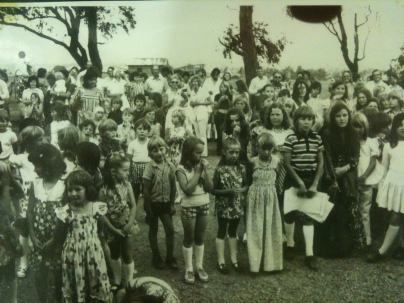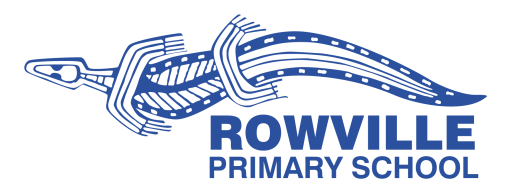Our School History
Our school was the first Primary School in Rowville, opening in 1973 with some 250 students. At that time it was a small school nestled amongst 23 acres of native flora and fauna. The site is now shared with the Western Campus of the large Rowville Secondary College. Our School has a modern Gymnasium and Canteen Complex plus Specialist areas for Library, Art, Music and L.O.T.E.
The school still retains some of the native bushland, and great care is taken to preserve the relaxed rustic nature of the site. This complements the peaceful, friendly environment remarked upon by so many visitors, and also enjoyed by our positive, happy student population.
Our facilities are constantly upgraded to meet the changing and evolving learning context. In 2006 two blocks of new permanent buildings were opened. In 2011 the floors of all classes that house the junior school were polished in order to create an environment that emulates elements of the Reggio Emilia philosophy. Our learning spaces include interactive whiteboards or projectors. Every class has access to digital technology which includes trolleys of laptops and digital cameras. In this way the use of technology is woven into the teaching and learning process. Information technology development for students and staff is seen as a vital priority to equip all participants for the future.
The outside environment is constantly evolving as we recognise that students learn through play. A new playground which was designed by Mary Geavons to encourage creative play was opened in 2007. The project was the result of a grant from the Investing in Schools Program and two years of fundraising by Friends of Rowville Primary School (FORPS). This is an example of how the parent community partners with the school to further enhance the learning environment.


In 2011 the Nganagee Building was officially opened. “Nganagee” was chosen as the name for the building. It means “a place of collaborating and celebrating’. We thought this name both reflected the cultural past and the way of learning for the future. The opening included a traditional “smoking ceremony” which was performed by a member of the Koori community. It was decided to incorporate this in the ceremony as Rowville has a strong Koori heritage. The school logo itself is based on aboriginal artwork.
Our school was informed in 2011 that we had been successful in obtaining a grant under the Stephanie Alexander Kitchen Garden program. The grant enabled us to develop a kitchen in the Nganagee building. One acre of playground adjoining the kitchen was earmarked for development into a kitchen garden. We want our students to learn to embrace the concepts of sustainability through cultivating fruit and vegetables and harvesting and preparing these in the kitchen.
In 2012 our outdoor synthetic sporting facility which includes a running track, a long jump pit, and a soccer and hockey field. This project is made possible by the enormous efforts of the FORPS group which has dedicated much time and effort in fundraising over several years.
We have been active members of the Stephanie Alexander Foundation since 2011 and our garden which contributes vegetables, herbs and eggs to our kitchen is continually expanding to increase our growing potential. The work undertaken since 2011 to establish our Stephanie Alexander Kitchen Garden has reached is culmination in 2014 with the creation of Il Frutteto dei Bambini (The Children’s Orchard).
Our House Names
In 1835 Melbourne was founded, two years later the first white settlers came to Dandenong and Captain William Lonsdale set up a Native Police force made up of Indigenous Australians from the local tribes.
The next year, 1838, the Reverend James Clow established the Corhanwarrabul Run and built his homestead which he called “Tirhatuan” after the Aboriginal name for the flying possums in the area. The run stretched all the way from Dandenong Creek to the Dandenong Ranges, which the Aborigines called Corhanwarrabul.
During this year the wife of the Governor of Van Diemens Land, Lady Eleanor Franklin visited the Native Police Force. She planted a tree that can still be seen down the end of Brady Road, near Churchill Park, along with the ruins of barracks used by the Native Police.
In 1882 the Row family built the Stamford Park Homestead (pictured) and named it after the town near Bourne, Lincolnshire, England where they had come from. At this time the area was well known for the horse stud farm associated with the Police Paddocks and the horses run by the Row family.
The Blacksmith around this time was named Nicholas Bergin. His shop was located just west of Bergins Road where it intersects with Stud Road. Mr Bergin became very well known and he suggested the name Rowville in honour of the Row family.
- Red - Bergin
- Yellow - Clow
- Green - Franklin
- Blue - Lonsdale
- Orange - Stamford (not in use)
- Purple - Row (not in use)


Our School Logo
Rowville Primary School has been here since 1973, and so has our school’s lizard logo. But have we ever really thought about the lizard’s history?
The lizard on our uniform is a blue-tongued lizard from the Wurundjeri tribe, a group of Aboriginal people! Sue Bonsall is the designer of our school logo, and the one who chose to have the famous blue-tongued lizard for our uniform.
The Wurundjeri tribe are people of the Indigenous Australian nation of the Woiwurrung language group, in the Kulin alliance, who occupy the Birrarung Valley, its tributaries and the present location of Melbourne, Australia. Prior to European settlement, they lived as all people of the Kulin nation lived, sustainably on the land, predominantly as hunters and gatherers, for tens of thousands of years.
The Wurundjeri peoples’ territory extended from north of the Great Dividing Range, east to Mount Baw Baw, south to Mordialloc Creek and west to Werribee River. Wurundjeri people take their name from the word wurun meaning Manna Gum which is common along the Birrarung, and djeri, a grub found in the tree.
We love our school logo, and we hope you love it too!
By Caitlin Alcock and Stephanie Wycklesma, 6CH and 6F (2010)
Sources: Rowville P.S website and Wikipedia!

From the beginning the outdoors has featured large in the life of Rowville Primary school pupils. The natural bushland setting provided such a magical playground during the early years of our history that we have endeavoured to create a similar experience for the children as the school has developed. Working closely with Coolabah Commercial Landscaping we have planted over fifty locally sourced trees and berries together with a winding path with an arbour leading to an outdoor learning area. In the future this will become a reading corner which will be hidden under a canopy of trees. The camouflaged space and mud rock seating around the outdoor area will provide opportunities for imaginative play and a meeting place for our environmental group.

The large hill outside the Nganagee building provided the setting for the excavation work needed to create the outdoor learning area and for the planting of the trees. Our small orchard has trees that include a variety of apple, pear and citrus, apricots, peaches, nectarines, plums, mulberry, quince, persimmon, babaco. A range of berries and currants have been planted to provide an aesthetic and sensory experience for our students. Our handyman, Les Shane and groundsman, Stewart Brown have installed a watering system to the site.
Children are heavily involved in the cycle of growing and seasonal change. We bring the outdoors into the classroom and we take the classroom out into our extensive natural environment that enables our pupils to experience at first hand the fascination that nature has to offer.

In 2016, following a successful grant application we were able to rejuvenate the lower playground with an inviting green lawn and the addition of soccer and AFL goals to complement the pre-existing playground equipment.

A Landcare Biodiversity Grant in 2018 enabled us to build a “frog bog” to increase our garden’s biodiversity. It provides significant learning benefits to our students around life cycles and ecosystems. It also help raise awareness amongst our students for the need to protect the environment.

